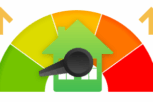The Fastest Ways to Upgrade Your EPC Rating in 2025: And Access Government Support
Upgrade Your EPC Rating With Government Support
Improving your EPC rating has never been more important. With rising energy costs, incoming policy changes, and increased pressure on landlords and homeowners to meet efficiency standards, 2025 is shaping up to be a decisive year for UK home energy upgrades. A higher EPC doesn’t just reduce bills. It boosts property value, futureproofs your home, and opens the door to valuable government grants like ECO4, GBIS, and the Home Upgrade Grant. Fortunately, upgrading your EPC rating doesn’t have to involve major renovations. With the right strategy, you can achieve meaningful improvements quickly and affordably, while taking advantage of available government support.
In this article:
- Upgrading your EPC rating in 2025 is easier and faster with high-impact measures like insulation, efficient heating systems, smart controls, and airtightness improvements.
- Homeowners can access major government support schemes, including ECO4, GBIS, HUG, and the Boiler Upgrade Scheme, to reduce or eliminate upgrade costs.
- Improving your EPC now boosts property value, cuts energy bills, and prepares homes for future UK energy-efficiency standards and regulations.

Upgrade Your Insulation — The Quickest Path to a Higher EPC
Improving insulation is the single most effective and fastest way to boost your EPC rating, and it remains the first measure energy assessors look for when calculating a property’s thermal performance. Poor insulation forces heating systems to work harder, wastes energy, and significantly lowers the EPC score — which is why insulation upgrades can transform a property’s rating almost overnight.
Heat naturally rises, making the loft one of the biggest sources of heat loss in UK homes. Up to 25% of a home’s heat can escape through an uninsulated loft, causing higher bills and a lower EPC. Installing or topping up loft insulation to the recommended 270mm depth can often be completed in under two hours, instantly improving a property’s overall thermal rating and reducing ongoing energy demand. Most homes built before 1990 benefit greatly from this upgrade.
Around one-third of heat loss occurs through external walls, and cavity wall insulation can dramatically reduce this. By injecting insulating material into the gap between the inner and outer brickwork, homeowners can significantly improve efficiency without major disruption.
The installation typically takes less than three hours, and for homes built between 1920 and 1990, this measure can add a substantial jump to your EPC rating. Many households qualify for free or subsidised cavity wall insulation through government schemes.
Older properties without cavity walls often suffer from severe heat loss. Solid wall insulation, applied internally or externally, provides some of the largest EPC improvements possible and can reduce heat loss by up to 45%. Although it is a more involved upgrade, it’s one of the highest-value measures for properties stuck in bands E, F, or G. External wall insulation also improves weather resistance and gives the property a fresh exterior appearance.
Timber floorboards and suspended floors can allow cold air to circulate beneath the home. Insulating floor voids can add meaningful improvements to comfort and EPC ratings alike.
Though not as impactful as loft or wall insulation, floor insulation still contributes to a higher EPC score and can work alongside other measures to move a home up one or even two EPC bands.
Insulation directly reduces the amount of energy your home requires to stay warm. Since EPC calculations focus on energy efficiency and long-term savings, well-insulated homes score significantly higher. For most properties, insulation upgrades alone can move the EPC from Band E or D to Band C, a key threshold for both homeowners and landlords.
Install a High-Efficiency Heating System

An outdated boiler is one of the biggest factors dragging down EPC performance. Replacing an old G-rated boiler with a modern A-rated condensing boiler can produce a large uplift in your EPC rating and reduce annual energy bills. For homes with appropriate insulation levels, heat pumps are becoming an increasingly popular upgrade option. Air source heat pumps provide high efficiency, lower emissions, and substantial EPC benefits. Under ECO4 and the Boiler Upgrade Scheme, eligible households can receive significant financial support to upgrade to a cleaner, more efficient heating system.

Switch to Smart Heating Controls
Smart thermostats and heating control systems can rapidly improve a property’s efficiency without any structural changes. These devices adjust heating output automatically, optimise temperature settings, and reduce unnecessary energy use. While they offer a smaller EPC boost compared to insulation or boiler upgrades, they can be installed quickly, are relatively low cost, and are now included in certain government retrofit schemes. Smart controls are especially beneficial for electrically heated homes, where intelligent energy management can make a noticeable difference to EPC calculations.
Improve Draught-Proofing and Airtightness

Draught-proofing is one of the simplest and most affordable ways to improve your EPC rating, yet it’s often overlooked. Even in homes with good insulation, unwanted air leakage through windows, doors, floorboards, chimneys, and pipe penetrations can significantly reduce energy efficiency. These gaps allow warm air to escape and cold air to enter, forcing your heating system to work harder and increasing energy bills. Simple upgrades such as replacing worn window seals, adding rubber door strips, fitting letterbox covers, or using chimney balloons can be completed quickly and deliver immediate improvements to thermal comfort and heat retention. While these may seem like small fixes, they collectively reduce a property’s overall heat demand, an important factor in EPC calculations.
For homes with more serious air leakage problems, professional airtightness improvements can make an even bigger difference. Installers can carry out air-pressure tests to locate hidden gaps and apply advanced sealing materials, airtight membranes, and insulation wraps around key areas such as loft hatches, window reveals, floor voids, and pipe entry points. These measures help create a more controlled, energy-efficient building envelope that maximises the impact of other upgrades like insulation and new heating systems. As a result, improving airtightness not only enhances comfort and reduces drafts but also strengthens your home’s EPC rating. Many government schemes, including ECO4, HUG, and GBIS, include draught-proofing as part of broader retrofit packages, making it a low-cost, high-value upgrade for homeowners in 2025.

Add Renewable Energy Solutions — Boost EPC Scores and Cut Energy Bills
Renewable energy technologies are becoming one of the most powerful ways to improve EPC ratings in 2025, driven by falling installation costs, rising energy prices, and major government incentives. Solar PV (solar electricity panels) offers one of the biggest long-term returns, generating free, clean electricity that reduces your reliance on the grid and lowers your carbon footprint. Even a modest 2–4 kW system can significantly reduce annual energy use, which directly increases your EPC score. Many installers can complete solar PV installations in just one or two days, and modern systems come with smart inverters and monitoring software to maximise efficiency. For homes where a full PV system isn’t suitable, solar battery storage is an increasingly popular upgrade. Batteries allow homeowners to store excess solar energy for use at night or during peak periods, reducing grid consumption and improving overall energy efficiency. Some EPC assessors also consider the combined impact of solar power and storage, which enhances your EPC rating even further.
Hot water systems can also benefit from renewable upgrades. Solar thermal panels use the sun’s energy to heat water, reducing the load on your boiler and lowering running costs. While solar thermal systems offer a smaller EPC boost than solar PV, they are still a valuable option for homes with high hot-water demand or limited electrical capacity. In off-gas or rural properties, pairing renewable technologies with heat pumps can create a highly efficient, futureproof system that delivers exceptional EPC improvements. Many of these measures can be supported through government schemes such as the Boiler Upgrade Scheme (up to £7,500 for heat pumps), ECO4 (for low-income households), and the Home Upgrade Grant (for off-gas homes). As a result, renewables are no longer niche, they are now one of the fastest-growing and most cost-effective ways to improve your EPC rating, reduce energy bills, and increase long-term property value.
Final Thoughts
Improving your EPC rating in 2025 doesn’t have to be expensive or disruptive. By focusing on the fastest and most effective upgrades, such as insulation, heating system improvements, airtightness, and smart controls, you can achieve substantial EPC gains in weeks rather than months. Combined with generous government support schemes, upgrading your home’s energy performance is more accessible than ever. Taking action now not only boosts comfort and reduces bills but also strengthens long-term property value and prepares your home for the evolving standards of the UK energy market.





